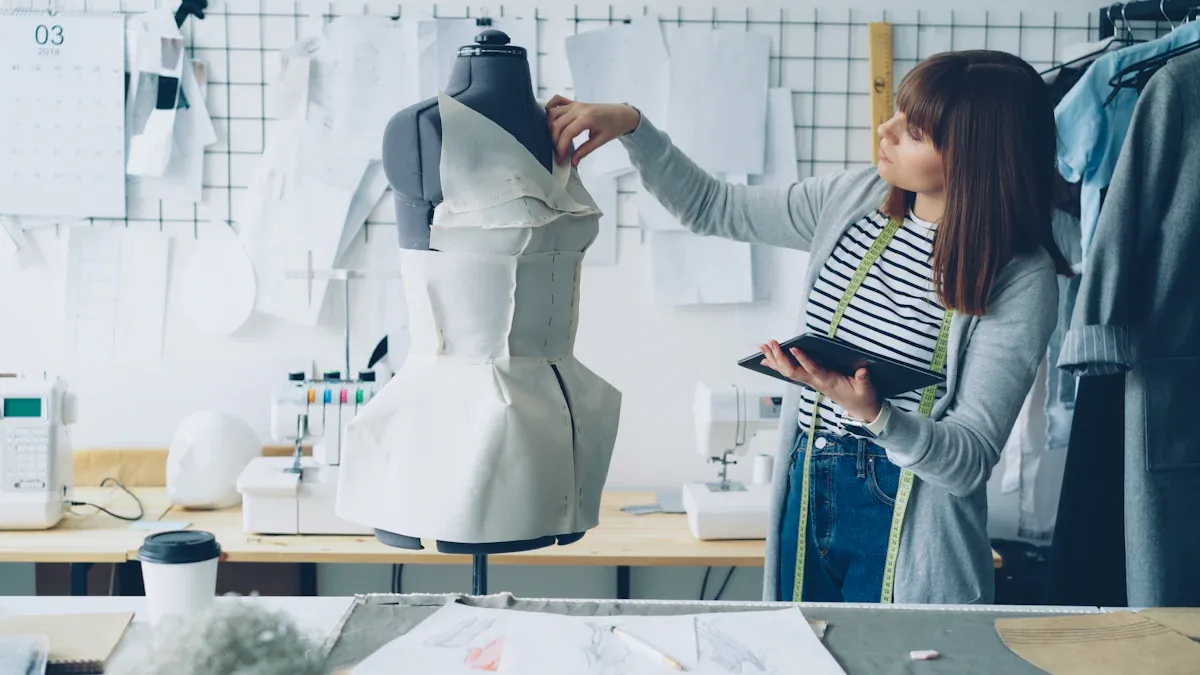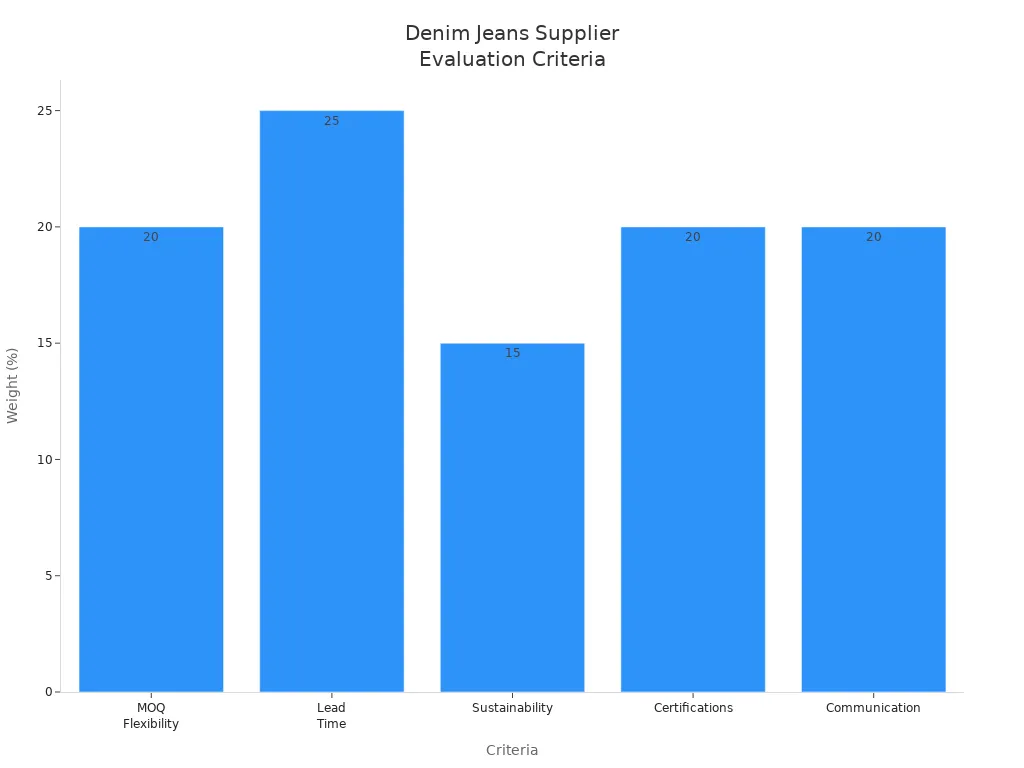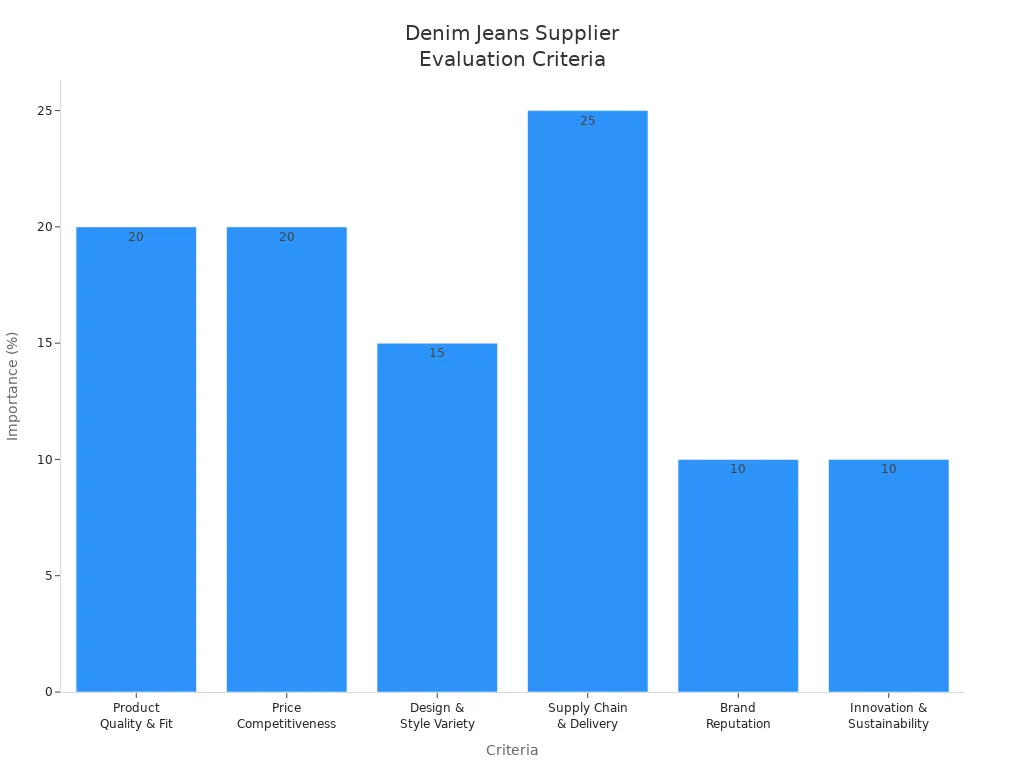
You want to launch your own denim brand and stand out in a crowded market. A structured plan helps you manage product development and choose a reliable denim jeans supplier. Custom solutions give you the freedom to create unique styles and access low minimum order quantities. Many entrepreneurs face challenges such as inventory management, quality control, and communication with suppliers. The table below shows common production hurdles:
Challenge | Explanation |
|---|---|
Digital Color Calibration | Color matching may be inaccurate without clear benchmarks. |
Incomplete Wash Protocols | Vague instructions can cause tonal inconsistencies. |
Loose Grading Guidelines | Size discrepancies often result from inconsistent grading. |
Fragmented Tech Packs | Multiple documents can confuse the production team. |
Zero Process Audits | Skipping audits leads to undetected defects. |
Inventory management and MOQ issues impact small denim brand owners.
Consistent clothing quality relies on effective communication and detailed tech packs.
Key Takeaways
Custom denim solutions allow you to create unique styles that reflect your brand identity, helping you stand out in a crowded market.
Understanding your target audience is crucial. Tailor your products to meet their needs for fit, style, and sustainability to build loyalty.
Effective communication with suppliers and detailed tech packs are essential for maintaining quality and managing production challenges.
Utilize low minimum order quantities (MOQs) to test new designs and reduce financial risk, allowing for flexibility in your product offerings.
A strong marketing strategy, including influencer partnerships and direct-to-consumer sales, can significantly boost your brand’s visibility and growth.
Why Choose Custom Denim Solutions
Unique Branding Opportunities
You want your denim brand to stand out in a crowded market. Custom denim solutions give you the power to create products that reflect your vision. You can choose every detail, from the fit and wash to the labels and trims. This level of control helps you build a strong identity for your denim brand.
You can order small quantities, which is perfect for launching limited edition collections or testing new ideas.
Custom denim lets you tailor jeans to specific measurements and styles, so your customers get a better fit and higher quality.
You can use eco-friendly fabrics and sustainable processes, which appeal to conscious shoppers.
You can add private branding, unique embellishments, and special washes to make your jeans truly one-of-a-kind.
Tip: Involve your customers in the design process. When people help create their jeans, they feel more connected to your brand and are more likely to become loyal fans.
Differentiating Your Denim Brand
Custom denim gives you a clear advantage over mass-produced products. You can offer features that big brands like Levi’s and Wrangler cannot match, such as unique designs and faster turnaround times. Your denim brand can stand out by focusing on quality, fit, and personal touches.
Custom denim solutions help you create distinctive design elements that show your brand’s personality.
You can build emotional connections with your customers, making your brand memorable.
Customization acts as a marketing tool, helping you reach new audiences and increase your visibility.
When you use custom denim, you set your denim brand apart from the competition. You give your customers something special, which helps your business grow and succeed.
Researching the Denim Market
Identifying Trends and Gaps
You need to understand the current landscape of the denim industry before you launch your denim brand. The denim industry changes quickly, so you must stay updated on trends and spot gaps in the market. Many brands now focus on eco-friendly products and sustainable practices. Light colored jeans have become popular because they work well for many occasions. Denim is also gaining acceptance in business casual settings, which opens new opportunities for your denim brand.
Trend | Description |
|---|---|
Eco-friendly Products | More shoppers want sustainable denim, so brands use organic cotton and recycled materials. |
Light Colored Jeans | These jeans are versatile and fit many styles, making them a top choice for custom designs. |
Business Casual Acceptance | Denim is now welcome in offices, so you can target professionals with your denim brand. |
Innovations in Material | New fabrics and features, like stretch and recycled fibers, shape what customers want. |
Note: The global premium denim market is shifting toward sustainability. Many shoppers want jeans that match their values and lifestyles.
You should also look at popular styles. Wide-leg and straight-leg jeans are trending, and relaxed fits are growing fast in online sales. If you offer these styles, you can attract more customers and fill gaps in the denim industry.
Defining Your Target Audience
You must know who will buy your jeans. The denim industry serves many groups, but you need to focus on the right audience for your denim brand. Surveys show that over 70% of people choose jeans for casual wear because they want comfort and style. This leads to strong brand loyalty and repeat purchases.
Category | Factors |
|---|---|
Demographic | Age Group, Gender, Income Level |
Psychographic | Lifestyle, Values, Personality Traits |
Fit and sizing matter for petite, tall, or curvy shoppers.
Fashion-conscious buyers want control over color, stretch, and wash.
Independent brands and designers look for private labels or no labels.
You can use these insights to shape your denim brand and create custom jeans that meet your audience’s needs. When you understand your target market, you make better decisions and stand out in the denim industry.
Building Your Denim Brand Identity
Crafting Your Brand Story
You need a strong story to connect with your customers. Your brand story shows what makes your denim brand unique. It helps people remember you and trust your products. Start by thinking about your values and the message you want to share. Ask yourself what inspired you to create your denim brand. Did you want to offer better fits, use sustainable materials, or bring new styles to the market?
A clear brand story builds emotional connections. You can use social media and influencer marketing to share your journey. When you tell your story, you invite customers to join your mission. Focus on what sets your denim brand apart, such as custom designs or eco-friendly fabrics.
Here are key elements that help you build a strong identity:
Key Element | Description |
|---|---|
Define Your Niche | Find a specific group in the denim market to target. |
Develop a Unique Product | Create jeans that stand out in quality, design, or technology. |
Build a Strong Brand Identity | Make your brand memorable and relatable. |
Embrace Digital Marketing | Use social media and influencers to reach more people. |
Prioritize Customer Experience | Give shoppers great service and easy shopping. |
Build a Sustainable Business Model | Use eco-friendly and ethical practices. |
Embrace Collaboration | Work with other brands or influencers to grow your audience. |
Tip: Share behind-the-scenes photos and stories to make your brand feel personal and authentic.
Planning Your Business Model
You need a solid business model to keep your denim brand profitable. Choose a model that matches your goals and resources. Some brands use fast fashion, which means quick production and low prices. Others focus on luxury, offering premium quality and exclusivity. Many new brands choose sustainable and ethical models, using eco-friendly materials and fair labor.
Here is a comparison of common business models:
Business Model | Key Characteristics | Advantages | Disadvantages |
|---|---|---|---|
Fast Fashion | Quick production, trend-driven, affordable pricing | Fast revenue, high demand | Environmental impact, high competition |
Luxury Fashion | Premium quality, exclusivity, strong identity | High profit, loyal customers | High costs, niche market |
Sustainable & Ethical | Eco-friendly, fair labor, transparent supply chain | Brand loyalty, positive impact | Higher costs, slower development |
Successful denim brands use smart marketing. You can work with influencers and encourage customers to share photos of your jeans. Segment your products in ads to reach the right buyers. Brands that use these strategies often see higher returns and lower costs.
Note: A sustainable business model attracts loyal customers who care about the environment.
Designing Custom Denim Jeans

Selecting Styles and Fabrics
You shape your denim brand by choosing the right styles and fabrics. When you design custom denim jeans, you decide how your products look, feel, and perform. Many custom brands use a range of fabrics to meet different needs. Here are some popular options:
Selvedge denim gives you durability and clean edges. Many traditionalists prefer this fabric for its classic appeal.
Stretch denim offers flexibility and comfort. You can use it for modern cuts that fit active lifestyles.
Raw denim remains unwashed and untreated. Over time, it molds to the wearer, creating a unique look.
Organic denim uses organic cotton. This eco-friendly choice works well for sensitive skin and appeals to conscious shoppers.
Lightweight denim feels breathable and flexible. You can use it for warm weather collections.
Heavyweight denim stands out for its thickness and toughness. It suits jeans designed for serious wear.
You select styles based on your target audience. Wide-leg, straight-leg, and relaxed fits attract different groups. When you match the right fabric with the right style, your custom denim jeans stand out in the market.
Tip: Test several fabric samples before you finalize your collection. You want your custom denim jeans to meet your customers’ expectations for comfort and durability.
Custom Labels, Rivets, and Trims
You build brand recognition by focusing on details. Every part of your custom denim jeans, from the waistband to the rivets, shapes your brand identity. Custom labels, rivets, and trims do more than add style. They elevate how people see your denim brand.
Custom labels, rivets, and trims enhance your brand identity.
These features improve how customers perceive your jeans.
Rivets reinforce stress points and tell your brand’s story.
You can use a branded tag on the waistband. Rivets at stress points make your jeans durable and iconic. The back pocket gives you space for unique branding elements. When you design custom denim jeans with these features, you create products that customers remember.
Choosing a Denim Jeans Supplier
Selecting the right denim jeans supplier shapes the future of your denim brand. You need to find reliable manufacturers who understand denim manufacturing and can support your growth. Many small brands struggle with high minimum order quantities, inconsistent quality, and poor communication. You can overcome these challenges by focusing on suppliers who offer flexibility, transparency, and sustainable practices.
Sourcing Low MOQ Suppliers
You want to test new styles and launch collections without risking too much capital. Many denim jeans suppliers set minimum order quantities (MOQs) between 200 and 500 pieces for startups. This range allows you to experiment with designs and manage inventory more easily. You should ask each denim jeans supplier about their MOQ policies before you commit.
Low MOQ suppliers help you test the market affordably.
You can launch limited runs and adjust your product line quickly.
Small orders reduce the risk of unsold stock.
You can also look for a private label manufacturer that offers one-stop customization. These suppliers let you create private label brands with your own logo, trims, and packaging. You gain control over your denim brand’s identity while keeping costs manageable.
Tip: Choose a denim jeans supplier close to your main market. You save on shipping and get faster delivery, which helps you restock popular styles quickly.
Evaluating Quality and Communication
You need to vet each denim jeans supplier for quality, reliability, and clear communication. Quality blue jean manufacturer partners help you build a strong reputation. You should check samples and visit factories if possible. Look for jeans manufacturers who use high-quality materials and advanced denim manufacturing techniques.
Here are the most important criteria to evaluate:
Criteria | Weight (%) | Importance |
|---|---|---|
MOQ Flexibility | 20 | Tests styles affordably. |
Lead Time | 25 | Meets seasonal launch deadlines. |
Sustainability | 15 | Aligns with brand values and customer demand. |
Certifications | 20 | Ensures quality, safety, and environmental compliance. |
Communication | 20 | Prevents costly misunderstandings. |

You should also check product quality and fit. A quality blue jean manufacturer uses durable fabrics and precise sizing. You can assess quality by looking at fabric composition, weight, texture, durability, color fastness, and finish.
Quality Indicator | Description |
|---|---|
Fabric Composition | Denim made from cotton and elastane offers comfort and stretch. |
Weight | Thick denim lasts longer and feels sturdy. |
Texture | Slightly rough texture softens with wear; avoid overly smooth fabrics. |
Durability | Pinch and stretch tests show fabric strength and seam quality. |
Color Fastness | Even dye and no color transfer indicate good dyeing processes. |
Finish | Smooth, natural sheen signals high-quality denim manufacturing. |
You need to communicate clearly with your denim jeans supplier. Good communication prevents mistakes and delays. You should ask for detailed tech packs and regular updates during bulk manufacturing. Reliable manufacturers respond quickly and solve problems before they grow.
Note: Suppliers with strong brand reputation and positive feedback often deliver better results. You can read reviews and ask for references from other private label brands.
Sustainable and Ethical Practices
You want your denim brand to reflect your values. Many customers now expect sustainable fabric materials and ethical denim manufacturing. You should choose a denim jeans supplier who uses eco-friendly practices and transparent labor policies.
Sustainable denim manufacturing focuses on several key areas:
Materials: Suppliers use organic cotton, recycled denim, hemp, and other sustainable options.
Water Use: Factories adopt water-saving technologies in farming and dyeing.
Chemicals: Manufacturers replace hazardous dyes and washes with safer alternatives.
Energy & Emissions: Suppliers improve energy efficiency and use renewable sources to lower carbon emissions.
Labor Practices: Workers receive fair wages and safe working conditions.
Waste & Circularity: Factories recycle water and chemicals, design jeans for durability, and encourage repair or recycling.
Many USA jeans manufacturers lead the way in sustainability. They use organic cotton and water-saving dyeing processes. You can ask your denim jeans supplier for certifications that prove their commitment to ethical denim manufacturing.
Criteria | Importance (%) | Explanation |
|---|---|---|
Product Quality & Fit | 20 | Ensures comfort, durability, and style. |
Price Competitiveness | 20 | Aligns with target customer segments. |
Design & Style Variety | 15 | Offers diverse fits and finishes for different tastes. |
Supply Chain & Delivery | 25 | Ensures reliability and flexibility in logistics. |
Brand Reputation & Feedback | 10 | Positive reviews indicate better long-term prospects. |
Innovation & Sustainability | 10 | Appeals to eco-conscious consumers. |

You can build a successful denim brand by choosing denim jeans suppliers who support sustainable denim manufacturing and offer bulk manufacturing options. You create jeans that meet customer expectations for quality, style, and responsibility.
Tip: Ask your denim jeans supplier about their sustainable fabric materials and water-saving technologies. You show your commitment to ethical denim manufacturing and attract eco-conscious shoppers.
Managing Production and Quality Control

You need to manage denim production carefully to build a successful denim brand. Every step, from prototyping to final inspection, shapes the quality and reputation of your products. You must set up a clear process to avoid costly mistakes and ensure your jeans meet high standards of quality.
Prototyping and Sample Approval
You start denim production with prototyping. This stage helps you see how your ideas look and fit in real life. You work with your supplier to create samples and make changes before mass production begins. Here is a typical process for sample approval:
Prototype Sample: You receive an initial sample to check fit and construction.
Pre-Production Sample: You review a sample that uses the final fabric, hardware, and wash.
Feedback & Revisions: You mark any changes needed. Limit the number of revisions to keep your timeline on track.
Approval: You give final sign-off before bulk denim production starts.
Tip: Always keep clear records of your feedback and approvals. This helps avoid confusion and ensures your supplier understands your expectations.
Overseeing Production Steps
You must oversee each step of denim production to keep your project on schedule. Production timelines can vary, but most denim manufacturers follow a similar process. The table below shows a typical timeline for custom jeans:
Type of Order | Production Time |
|---|---|
Fabric & Trims Sourcing | 10–15 days |
Sampling | 7–10 days |
Bulk Manufacturing | 25–40 days |
Final Inspection & Shipping Prep | 7 days |
You should communicate with your supplier at every stage. Ask for updates and photos during denim production. This helps you spot problems early and make quick decisions. You can also visit the factory or use video calls to check progress. Staying involved reduces delays and keeps your denim brand on track.
Ensuring Consistent Quality
You need strong quality control to deliver jeans that meet customer expectations. Quality control in denim production protects your reputation and reduces waste. It also saves money by catching problems before they reach your customers.
Effective quality control in denim production is essential for producing high-quality products. It ensures that denim items meet high standards, reduces waste, minimizes rework costs, and increases productivity.
You can use these steps to maintain consistent quality:
Fabric Inspection: Check for weaving defects, shade variation, slubs, stains, or holes.
Trims and Accessories Check: Inspect zippers, buttons, rivets, and labels for durability.
Cutting Inspection: Make sure cut panels match the pattern for shape and size.
Sewing Quality Check: Look for even stitching, balanced tension, and strong seams.
In-Process Inspection: Randomly check jeans during sewing to catch errors early.
Washing and Finishing Check: Confirm wash effects are consistent and shades match.
Final Measurement Check: Measure key points and compare with your size chart.
Defects Classification: Sort defects as Major, Minor, or Critical.
Final Inspection: Use the AQL (Acceptable Quality Level) standard to inspect packed jeans.
The denim fabric inspection machine has revolutionized the inspection process, allowing for quick adjustments to improve overall quality and prevent defects from occurring in the future.
You should also implement structured random inline inspections and control defects at critical stitching stations. Manage wash recipes and loads to keep results consistent. Perform regular shade reviews and measurement checks to ensure every pair meets your denim brand’s promise.
By following these steps, you build trust with your customers and set your denim brand apart in the market. You show your commitment to high standards of quality and reliable denim production.
Logistics and Launch Preparation
Handling Shipping and Inventory
You need a clear plan for shipping and inventory management before you launch your denim brand. Many new brands face challenges such as overstock, cash flow problems, and delays. You can avoid these issues by understanding which styles drive revenue and by reordering bestsellers quickly. Real-time updates from suppliers help you keep launch timelines on track.
Common logistics challenges include:
Developing too many products too fast can lead to overstock and cash flow issues.
Failing to reorder bestsellers causes lost momentum.
Underestimating lead times frustrates customers.
Scaling operations too soon creates chaos.
Ignoring margin planning leads to financial problems.
You can use smart inventory strategies to stay organized. The table below shows helpful methods for small brands:
Strategy | Description |
|---|---|
Analyze Sales and Trends | Review past sales and market trends to predict demand. |
Use a Centralized Platform | Track inventory in real time to avoid errors. |
Liquidate Unsold Stock | Set rules for markdowns or clearance events to move slow items. |
Track Inventory in Batches | Organize stock by launch date for better sell-through rates. |
Set Dynamic Safety Stock | Keep buffer stock based on sales speed to prevent stockouts. |
Align Marketing with Inventory | Sync campaigns with inventory levels to avoid overselling. |
Use Aging Reports | Check for slow-moving items and reduce dead stock. |
Tip: Communicate early with suppliers and use batch tracking to prevent costly surprises.
Preparing for Launch
You set your denim brand up for success by preparing carefully. Start with market research and define your target audience. Estimate costs and create a budget. Build a brand identity that excites your customers. Register your business and follow legal requirements.
Follow these steps for a smooth launch:
Research the market and target audience.
Plan your finances and budget.
Create a strong brand name and identity.
Register your business and meet compliance rules.
Develop high-quality denim products.
Plan marketing and set up sales channels.
Launch with a small release, gather feedback, and promote on social media.
You can avoid delays by understanding timelines and keeping communication open with suppliers. Real-time updates help you align expectations and prevent budget overruns. When you launch, focus on bestsellers and use feedback to improve future collections.
Note: Sync your marketing with inventory levels to keep customers happy and avoid overselling.
Marketing Your Denim Brand
Setting Up Sales Channels
You need to choose the right sales channels for your denim brand. Many new brands succeed by using both offline and online options. Offline channels, such as hypermarkets, supermarkets, and specialty stores, attract shoppers who want to touch and try on jeans before buying. These stores account for nearly 78.8% of revenue because people value the in-person experience.
Online sales channels grow quickly. You can reach more customers by selling through your website or social media. Digitalization and direct-to-consumer models help you build relationships and control your brand image. Many successful brands use an omnichannel approach, blending in-store shopping with online convenience. This strategy lets you offer seamless service and reach shoppers wherever they prefer.
Tip: Start with a few channels and expand as your denim brand grows. Track which channels bring the most sales and adjust your plan.
Building a Marketing Strategy
You need a strong marketing strategy to make your denim brand stand out. Selling direct-to-consumer gives you higher profit margins and more control over your message. You can use your own store or social media to connect with buyers.
Partnering with influencers helps you reach new audiences. Influencers showcase your custom designs and build trust with their followers. Offering limited editions creates excitement and urgency. Shoppers want exclusive products, so small-batch drops often sell out fast.
Expanding your product line keeps your marketing fresh. You can introduce new fits, washes, or accessories once you have loyal customers. This approach helps you scale your denim brand and stay relevant.
Marketing Strategy | Benefit |
|---|---|
Direct-to-Consumer Sales | Higher margins, brand control |
Influencer Partnerships | Wider reach, brand awareness |
Limited Editions | Urgency, exclusivity |
New Styles & Accessories | Growth, customer retention |
Note: Review your marketing results often. Adjust your marketing strategy to match what your customers want and how they shop.
Scaling Your Custom Denim Brand
Strategies for Growth
You can grow your denim brand by using proven strategies that successful companies follow. Many brands focus on building a loyal community and reaching more customers. You should consider these approaches:
Offer a wide range of sizes. Good American, for example, includes sizes from 00 to 32. This inclusivity helps more people feel welcome and builds loyalty.
Use both wholesale and direct-to-consumer sales. Selling through stores and your own website lets you reach shoppers in different places.
Share real stories in your marketing. Authentic campaigns connect with people better than traditional ads.
You can also partner with influencers or local businesses. These partnerships help you reach new audiences. Track your sales data to see which products perform best. Adjust your strategy based on what your customers want.
Tip: Stay active on social media. Respond to comments and messages to build trust with your followers.
Expanding Product Lines
You can scale your denim brand by adding new products. Start by listening to your customers. Ask them what styles, colors, or fits they want next. Use surveys or social media polls to gather ideas.
Here are ways to expand your product line:
Expansion Idea | Benefit |
|---|---|
New Fits (e.g., flare, skinny) | Attracts different style preferences |
Seasonal Collections | Keeps your brand fresh and relevant |
Accessories (e.g., jackets, hats) | Increases average order value |
Sustainable Options | Appeals to eco-conscious shoppers |
You should test new products with small batches. This approach reduces risk and helps you learn what sells. When you see strong demand, increase production. Keep your quality high as you grow. Customers will notice your attention to detail and return for more.
Note: Expanding your product line can set your denim brand apart from competitors and keep your customers excited.
Overcoming Common Challenges
Navigating MOQs and Costs
You face several challenges when you start a denim brand, especially with minimum order quantities (MOQs) and costs. Many suppliers set high MOQs, which means you need a large upfront investment. This can lead to overstocking and increased storage fees. Changing trends may leave you with unsold stock, forcing you to offer markdowns or waste products.
Challenge | Impact on Business |
|---|---|
High MOQs | Requires large capital investment upfront |
Overstocking | Increased warehouse costs and storage fees |
Changing Trends | Unsold stock leads to markdowns or waste |
You can choose private-label suppliers with low MOQs to reduce risk. Smaller production runs help you test new designs and respond quickly to market demand. This approach lets you invest more in marketing and branding instead of excessive inventory. You also support sustainability by minimizing waste.
Cost efficiency improves your cash flow.
Faster market response keeps your brand relevant.
Sustainability practices help you build an eco-friendly reputation.
Maintaining Quality Standards
You need to maintain high quality standards as your denim brand grows. Rigorous quality control helps you avoid defects and meet regulations. Advanced dyeing techniques improve color consistency and fabric performance. Finishing treatments add durability and comfort, which increases customer satisfaction. Automated inspection systems reduce human error and speed up manufacturing.
Method | Description |
|---|---|
Rigorous Quality Control | Ensures defects are minimized and improves compliance. |
Advanced Dyeing Techniques | Enhances color consistency and fabric performance. |
Finishing Treatments | Improves durability and comfort for customers. |
Automated Inspection Systems | Reduces human error and increases manufacturing speed. |
You should inspect fabric weight and thickness, test stretch recovery, and check colorfastness. Early defect detection and durability tests help you deliver reliable products. Review supplier certifications and use lean principles to reduce waste. Private-label brands often use these methods to maintain quality and build trust.
Addressing Sustainability
You must address sustainability challenges in custom denim manufacturing. Producing a single pair of jeans can use up to 7,500 liters of water, which is not sustainable. The dyeing process often involves toxic chemicals that pollute water sources and harm local communities. Denim production also adds to global carbon emissions because of energy-intensive processes and transportation.
Water usage remains a major concern for denim brands.
Chemical pollution affects both the environment and people.
Carbon emissions from manufacturing and shipping contribute to climate change.
You can choose private-label suppliers who use water-saving technologies, non-toxic dyes, and renewable energy. These steps help you create a responsible denim brand that appeals to eco-conscious customers.
You can launch a successful denim brand by following a clear plan. Focus on customization, low minimum orders, and direct sales to build exclusivity.
Denim remains a timeless product.
Customization sets your brand apart.
Simple ordering and transparent pricing help you start strong.
Direct-to-consumer sales and influencer partnerships drive growth.
Start by creating mockups, testing samples, and developing collections. Set up your online store, add detailed product descriptions, and market your brand. The custom denim market offers exciting opportunities for creative entrepreneurs.
FAQ
What is the minimum order quantity (MOQ) for custom denim jeans?
Most suppliers offer MOQs between 200 and 500 pieces. You can find some manufacturers who accept lower MOQs for startups. Always ask your supplier about their MOQ policy before you place your first order.
How do you ensure the quality of custom denim jeans?
You should request samples before bulk production. Inspect fabric, stitching, and fit. Communicate your expectations clearly. Reliable suppliers provide updates and allow you to review products at each stage. Quality control checks help you avoid costly mistakes.
Can you create eco-friendly denim products?
Yes, you can choose organic cotton, recycled materials, and water-saving processes. Many suppliers now offer sustainable options. Ask for certifications to confirm their eco-friendly practices. Eco-friendly denim appeals to conscious shoppers and strengthens your brand.
How long does it take to produce custom denim jeans?
Production usually takes 30 to 60 days. This timeline includes sourcing materials, sampling, manufacturing, and shipping. Timelines may vary based on order size and design complexity. Always confirm the schedule with your supplier.
